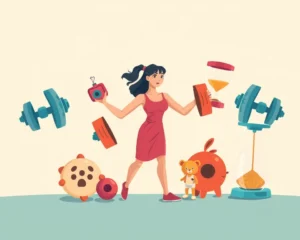Cycling is often celebrated as a healthy and eco-friendly activity, but for some, the passion can turn into an unhealthy obsession. While regular cycling offers numerous physical and mental health benefits, an excessive focus on riding can lead to exercise addiction, a condition with significant negative consequences. This article explores the fine line between a healthy dedication to cycling and a potentially dangerous addiction.
The Allure of the Pedal: Benefits of Cycling
Cycling is a low-impact exercise that provides an excellent cardiovascular workout, strengthening the heart and lungs. It improves muscle strength and flexibility, enhances joint mobility, and can aid in weight management. Regular cycling is also associated with reduced risks of cardiovascular diseases, type 2 diabetes, and some cancers. Beyond the physical, cycling offers a significant boost to mental health. It can reduce stress, anxiety, and depression, and the rhythmic nature of the activity can promote mindfulness and relaxation. Cycling also fosters a sense of community, with opportunities to connect with others through group rides and clubs. Many cyclists report that being outdoors in the fresh air improves their mood and mental clarity. Studies have even shown that cycling to work can reduce the likelihood of needing medication for anxiety or depression.
The “Runner’s High” and Cycling
The release of endorphins during exercise, often described as a “runner’s high,” is a significant factor in the appeal of cycling. These endorphins produce feelings of euphoria, well-being, and reduced pain perception, similar to the sensations experienced by those with other types of substance addiction. The body’s natural reward system can make cycling highly addictive as the brain starts to crave the positive feelings it gets from the activity.
When Passion Becomes Problematic: The Dark Side of Cycling
While the benefits of cycling are clear, it’s important to recognize when a healthy habit transforms into an unhealthy obsession. Exercise addiction, also referred to as compulsive exercise or exercise dependence, is characterized by a loss of control over one’s exercise habits. It involves a dependence on cycling that leads to negative consequences in one’s health, social life, and professional life. Multiple studies show that cyclists, along with runners, are more susceptible to this addiction compared to other athletes. One study of Spanish club cyclists revealed that 17% met the criteria for exercise addiction, compared to just 0.3-0.5% of the general population.
Defining Exercise Addiction
Exercise addiction is not defined by the number of hours spent on the bike, but rather by the impact it has on other areas of life. It’s the incessant internal need to ride, often to the point of ignoring responsibilities, relationships, and the body’s need for rest and recovery. Addicted cyclists often rearrange their priorities to prioritize riding over everything else.
Signs of Cycling Addiction
Several warning signs may indicate that a cyclist is moving from dedication to addiction:
- Compulsive Thoughts: Experiencing remorse and regret for missed cycling sessions, or feeling that other daily tasks are dull and irritating.
- Mood Swings: Experiencing depression, frustration, and negative thoughts related to perceived drops in fitness levels.
- Withdrawal Symptoms: Feeling moody, irritable, or anxious when unable to cycle.
- Prioritization: Cycling taking precedence over work, social events, family obligations, and even basic needs such as sleep and proper nutrition.
- Ignoring Concerns: Disregarding pleas from loved ones to cut back on cycling.
- Increased Tolerance: The need to ride more and more to achieve the same level of satisfaction.
- Diminished Returns: Experiencing decreased performance despite increased training.
- Physical Symptoms: Recurring aches and pains, frequent injuries, and a susceptibility to colds and illnesses.
- Loss of Interest: A potential distaste for the sport itself due to overexertion and burnout.
- Obsessive Behavior: Having a detailed knowledge of every pothole in a 5-mile radius, or needing to restart a ride if a tracking device fails.
- Using cycling to manage emotions: Utilizing exercise to cope with anger, anxiety, grief, and stress.
The Cycle of Addiction
Exercise addiction often begins with the initial euphoria experienced from cycling. Over time, this temporary escape turns into a coping mechanism. The individual develops a tolerance, needing to ride more and more to achieve the same effect. The addiction cycle becomes difficult to break without intervention, as it leads to a vicious pattern of dependence. The sense of control that exercise provides, particularly over mood and body, reinforces the addictive behavior.
The Physical Toll of Excessive Cycling
While cycling is generally low-impact, excessive training can lead to a host of physical problems:
- Overtraining Syndrome: Chronic fatigue, decreased performance, sleep and digestive issues, irritability, and loss of motivation, all signs of overtraining, which can be accompanied by a sense of disgust with the sport.
- Musculoskeletal Issues: Muscle soreness, pain, injuries, and loss of strength due to overexertion.
- Muscular Imbalance: Overdeveloped leg muscles with weaker arms and core, potentially leading to a “skinny” appearance with neglected upper body strength.
- Joint Problems: Inflammation of ligaments and joints, patellar tendinitis and iliotibial band syndrome due to repetitive movements.
- Nerve Damage: Numbness, tingling, and pain in the hands, toes, and intimate areas due to pressure on nerves. Ulnar neuropathy can occur due to compression of the ulnar nerve when gripping handlebars.
- Genitourinary Issues: Potential for prostate problems, erectile dysfunction, and urinary tract issues in both men and women due to pressure on the perineum.
- Reduced Bone Density: Cycling, as a non-weight bearing exercise, does not promote bone strength. This can lead to a decrease in bone density, especially if cycling is the sole form of exercise, increasing the risk of fractures.
- Saddle Sores: Sores in the thighs and near the genitals caused by excessive pressure on nerves.
- Cardiovascular Stress: Although beneficial in moderation, excessive cycling can cause added stress on the heart.
Injury Risks
Poor bike fit, incorrect riding postures, and neglecting safety measures can lead to injuries such as:
- Abrasions, lacerations, and hematomas: Common injuries, especially from falls.
- Fractures: The clavicle is the most prevalent fracture among cyclists.
- Head injuries: Concussions and other head traumas due to accidents.
- Overuse Injuries: Patellofemoral syndrome is a common overuse diagnosis among cyclists.
- Neck and Shoulder Pain: Sustained postures while cycling can lead to pain and discomfort due to reduced blood flow and tissue impingement.
- Lower Back Pain: Can be caused by a sustained flexed position while cycling, particularly with an improper bike setup.
Balancing Passion and Well-being
It’s crucial for cyclists to find a healthy balance between their passion for riding and the other important aspects of their lives. Here are some tips:
- Plan Ahead: Set specific times for work, family, and cycling.
- Be Flexible: Accept that life demands can shift, and be willing to adjust cycling plans when needed.
- Set Realistic Goals: Focus on achieving consistency rather than aiming for overly ambitious training regimes.
- Vary Your Training: Incorporate cross-training activities to prevent muscle imbalances and strengthen bones, including weight training and impact activities like running.
- Listen to Your Body: Pay attention to signs of fatigue, pain, and decreased performance, and allow for adequate rest and recovery.
- Maintain a Work-Life Balance: Set boundaries between work and cycling time, and include family and friends in activities whenever possible.
- Prioritize Nutrition and Hydration: Fuel your body with proper nutrition and stay adequately hydrated to support both work and cycling activities.
- Seek Professional Help: If you are experiencing symptoms of addiction, consult with a therapist or a health professional specializing in exercise addiction.
Cycling as a Tool for Recovery
Interestingly, cycling can also be beneficial for those recovering from other addictions. The physical activity helps the body to feel good naturally, releases endorphins, and can be a great stress relief. It can also provide a positive focus and help restore the brain’s balance of mood-elevating chemicals, which is often disrupted by substance abuse. Engaging in group cycling activities can also foster a sense of community and support, further aiding in the recovery journey.
Conclusion
While cycling offers numerous health benefits, it’s essential to recognize that too much of a good thing can be detrimental. The key is to be mindful of your motivations, prioritize balance, and seek help if you suspect your passion for cycling has crossed the line into an unhealthy addiction. By being aware of the potential risks and actively managing your habits, you can enjoy the many benefits of cycling without compromising your overall well-being. Remember, a healthy relationship with cycling enhances your life, while an addiction detracts from it.







